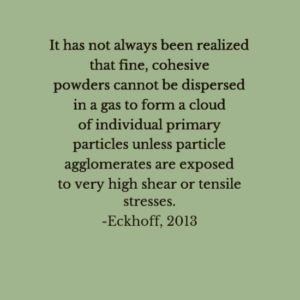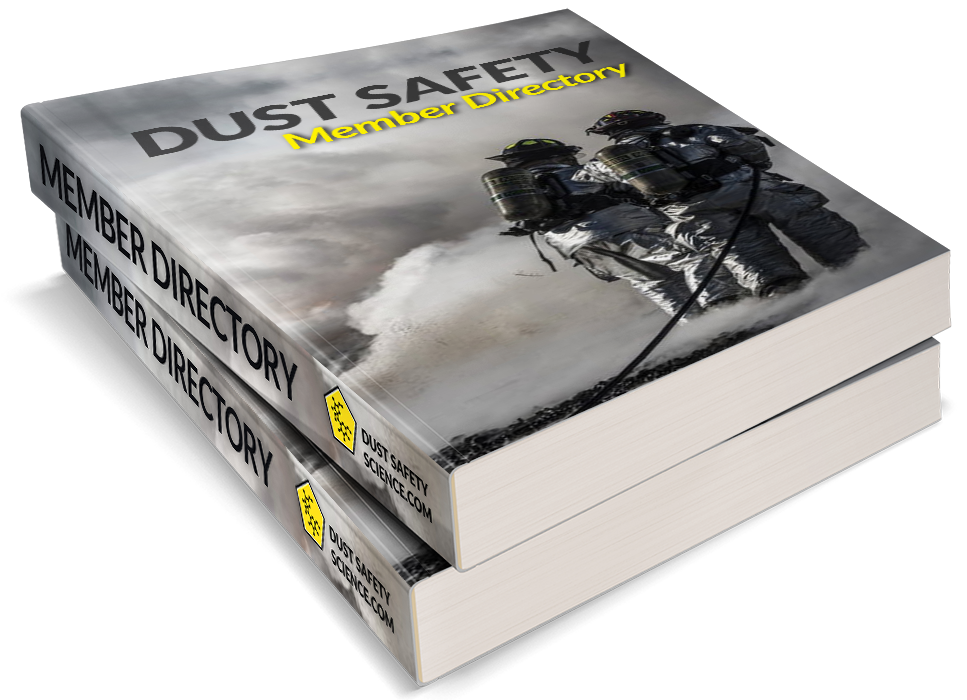1-Sentence-Summary: Ignitability and explosion violence of nanometric dust particles may not be as severe as predicted by extrapolating micrometric particle trends down into the smaller particle size range.
Authors: R. Eckhoff
Read in: Three Minutes
Favorite quote from the paper:

This paper gives a review of the dust explosion risk presented by powders of very small individual particle diameter. A review of the fundamental aspects of cloud formation and the time-varying effective particle size in the cloud is given. This is followed by a review of explosion severity testing and minimum ignition energy (MIE) testing for nanometric dusts. The paper concludes with a discussion of the practical consequences for industrial safety involving nanometric particle sizes.
Three of the main findings from this paper are:
- Difficulties in cloud formation of individual primary particles and rapid particle collision and coagulation (agglomeration) increase the effective size of nanomertic particles in practical situations.
- Explosion severity of nanometric particles is similar to particles of individual sizes in the micrometric range.
- Ignition sensitivity of nanometric metal particles may be significantly higher than particles of individual sizes in the micrometric range.
The following sections outline the main findings in more detail. The interested reader is encouraged to view the complete article at the link provided below.
Finding #1: Difficulties in cloud formation and particle coagulation increase the effective particle size of nanometric powders
From fundamental considerations and presentation of experimental results, the current author demonstrates that nanometric powders are difficult to disperse as primary particles. He states that the “dispersibility” of a powder is dependent on two aspects: the work required to break the particle-particle interaction forces at their given state, and the effectiveness of the process being used to perform this work.
As the individual particle size decreases at a given concentration, the number of particles per unit volume increases. Therefore, the spacing between individual particles decreases leading to enhanced particle-particle attraction (e.g., van der Waal’s forces). Moisture content, particle size distribution, and electrostatic charge can also increase the particle-particle attraction. Experimental data from Yamamoto et al., 1984 is presented to demonstrate the effects of particle size on the difficulty in dispersing talc dust into its primary particle size distribution.
The second observation is that once formed a cloud of primary nanometric particles would have many particle-particle collisions leading to coagulation (agglomeration) and a rapid decrease in effective particle size. From fundamental considerations the author proposes that clouds of primary nanometric particles would coagulate with 10s of milliseconds leading to a larger effective particle size during an explosion. Particle size distribution, particle shape, and turbulence level are all estimated to have an effect on this coagulation time.
At the end of this paper the author gives a discussion of these effects on experimental testing of dust explosion. He suggests that due to the differences in experimental ignition delay times and the actual ignition times in industrial process, experimental testing may not be using the “correct” or truly representative particle size seen in the industrial explosion. Caution is encouraged in applying laboratory-scale testing to industry explosion analysis involving nanometric particles.
Finding #2: Explosion severity of nanometric particles is not significantly larger than micrometric particles
The current author presents a review of the explosion data from Vignes et al., 2009 and Holbrow et al., 2010 for nanometric powders. These results show that explosion severity as measured from the maximum rate of pressure rise was similar to, or in some cases lower than, micrometric powders. The current author suggests that this is due to the difficulties in dispersing the cloud of primary particles and rapid coagulation. He also suggests that explosion venting, suppression and isolation should be as feasible for nanometric powders as it is with micrometric dusts.
Finding #3: Nanometric metal powders have in some cases shown significant increase in ignition sensitivity
Experimental results of Wu et al., 2009, Randeberg at al and Eckhoff, 2007, and Wu et al., 2010 are briefly reviewed and demonstrate that the minimum ignition energy of some metal powders may be significantly smaller than micrometric particles. It is hypothesized that the high spark temperature of the MIE apparatus may cause thermal degradation of agglomerates and reduction to the primary particle size.
Furthermore, low ignition energies for metals have also been shown in other experimental setups. In an extreme case Wu et al., 2010 saw that metal powers exploded during dispersion into the 20-L chamber without an ignition source. This suggests that mechanical friction or electrostatic buildup may be strong enough to ignite these dusts.
My Personal Take-Aways From
“Influence of Dispersibility and Coagulation on the Dust Explosion Risk Presented by Powders Consisting of nm-Particles”
This article is essential reading for anyone studying the explosion hazard associated with nanometric powders. Industries using these powders should also be aware of both the explosion severity and ignition sensitivity of these materials. More summaries on the topic of explosion of nanometric powders can be found under the “nanometric powders” tag. Other articles in this field which have not been reviewed to date include Wu et al., 2010, Boilard et al., 2012, Turkevich et al., 2015, and Zhang et al., 2016.
Full Citation: [bibtex file=references.bib key=Eckhoff2013]
[otw_shortcode_button href=”http://www.sciencedirect.com/science/article/pii/S0032591013001150″ size=”medium” icon_position=”left” shape=”square”]> > Get The Article[/otw_shortcode_button]
